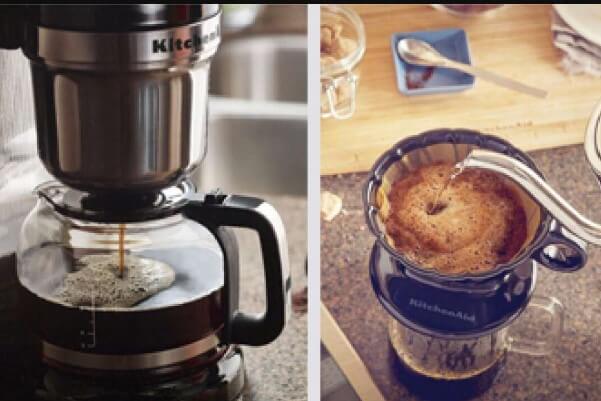
drip coffee vs pour over
Did you know that in America alone, people drink a staggering 400 million cups of coffee daily? It’s true!
Coffee has become an integral part of many people’s daily routines. Countless individuals feel like they simply cannot start their day without the invigorating and aromatic experience of a freshly brewed cup of java.
When it comes to brewing coffee, there are several methods to choose from, but two popular ones that often spark a debate are drip coffee vs pour over. Both methods are different in their own ways and can produce a delicious cup of joe. In this article, we will dive into the world of drip coffee and pour over to explore which method offers a better flavor experience.
What Is Drip Coffee?
Drip coffee is a popular brewing method that utilizes a drip coffee maker to create a flavorful cup of joe. It is a straightforward and convenient process that is popular due to its ease of use. Here’s a closer look at what drip coffee entails:
Drip Coffee Equipment
Drip coffee requires a drip coffee maker. This drip coffee maker consists of the following:
- A water reservoir
- A filter basket
- A carafe or pot to collect the brewed coffee
Ground Coffee
The process starts by adding ground coffee to a paper or reusable filter placed in the filter basket. The coffee grounds should be of a medium to coarse grind size, suitable for best extraction.
A Water Reservoir
Water is poured into the water reservoir of the coffee maker. The machine then heats the water to an ideal temperature for brewing. This is usually between 195°F to 205°F (90°C to 96°C).
The Brewing Process
Once the water reaches the right temperature, it gradually drips over the coffee grounds in the filter. The process is as follows:
- The water flows through the coffee
- It brings out the flavors and oils from the coffee grounds
- Then drips down into the carafe or pot below
Carafe or Pot
The carafe or pot collects the brewed coffee, which is now ready to be enjoyed.
Removing the carafe from the heating element after brewing is important. This will prevent the coffee from becoming over-extracted and bitter.
Drip coffee offers a convenient way to make a consistently delicious cup of coffee with a clean flavor profile.
What Is Pour-Over Coffee?
Pour-over coffee is a manual brewing method. You pour near-boiling hot water over coffee grounds in a controlled and precise manner.
This method lets you brew coffee yourself. Your choices determine your perfect cup of coffee. Customize it to your liking! Here’s a closer look at the process of making pour-over coffee:
Equipment Used
To make pour-over coffee, you’ll need a pour-over dripper (such as a Hario V60 or Chemex), a paper filter, a scale for precise measurements, a kettle for heating water, and a gooseneck kettle for controlled pouring.
Coffee-to-Water Ratio
The first step is to measure the right amount of coffee grounds and water. The recommended coffee-to-water ratio is typically around 1:15 or 1:16. But it can be adjusted based on personal preference.
The Grind Size
The coffee beans should be ground to a medium-coarse consistency. This is to ensure proper extraction during the brewing process.
Blooming the Coffee Grounds
Start by wetting the paper filter in the dripper. Place it over your cup or carafe. Add the coffee grounds and pour a small amount of just-off boiling hot water. Use about twice the water to the weight of the coffee over the grounds to allow them to bloom.
This step helps release trapped gases and prepares the coffee for extraction.
Method of Pouring
Pour hot water slowly and steadily over the coffee grounds. Start from the center and move in concentric circles toward the outer edges. The aim is to saturate all the grounds evenly and maintain a consistent flow rate.
Flavor Extraction Time
The total brewing time for pour-over coffee typically ranges from two to four minutes. This depends on factors like grind size and desired strength. Experimenting with different brewing times can help fine-tune the flavor.
Pure Enjoyment
Once the water has fully dripped through the filter, your pour-over coffee is ready to be savored. Enjoy the coffee in your favorite mug or cup. Breathe in the rich aroma and taste the coffee flavor.
Drip Coffee vs Pour Over
Drip coffee is rich and strongly flavored. Using a paper filter helps remove sediment from coffee grounds. This produces clear, smooth coffee. The brewing process is quite speedy.
One advantage of drip coffee is that it allows for consistency in flavor. You can expect a consistent taste with each brew once you find the right coffee-to-water ratio and brewing time. This makes it a reliable choice for those who prefer a familiar and dependable cup of coffee every morning.
Pour-over coffee provides a more hands-on and artistic approach to brewing. The precision pouring and control over variables allow coffee enthusiasts to explore different flavors.
It’s a method that rewards patience, skill, and a passion for the craft of coffee brewing. The slower brewing time allows the flavors to develop fully, producing a richer and more complex taste. For more on coffee, go to https://coffeeprudent.com/.
It’s a Personal Choice: Drip Coffee vs Pour-Over!
Ultimately, determining which method has better flavor depends on personal preference. While drip coffee offers convenience and consistency, pour-over coffee provides an opportunity to experiment and discover the subtle tastes of different beans.
When it comes to drip coffee vs pour over, the quality of your ingredients and the care you put into brewing will greatly impact the final taste of your coffee. Happy brewing!
Are you on a journey to prioritize your health and well-being? Look no further! Search our website. It’s your one-stop platform for all things health-conscious and nutritious.
Our platform is dedicated to empowering you with valuable insights, tips, and resources straight from the domain of the health sector.








